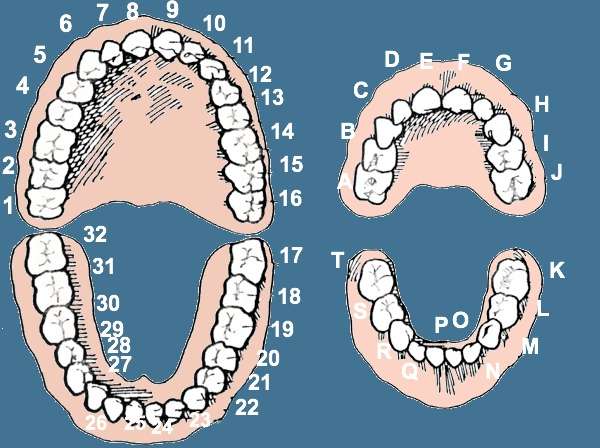Dental numbers

- Adult (permanent) teeth identified by numbers
- From the midline to the back of the mouth on each side, there is a central incisor, a lateral incisor, a canine, two premolars (bicuspids), and three molars
- Children (non-permanent) teeth identified by letters
- Common landmarks:
- 1: Right upper wisdom
- 8 & 9: Upper incisors
- 16: Left upper wisdom
- 17: Left lower wisdom
- 24 & 25: Lower incisors
- 32: Right lower wisdom
Tooth descriptors
- Maxillary teeth: upper row
- Mandibular teeth: lower row
- Facial: Portion of tooth seen when the mouth is open/smiles. Applicable to all teeth
- Labial: facial surface of the incisors and canines
- Buccal: facial surface of the premolars and molars
- Oral: Portion of tooth that faces the tongue or palate. Applies to all teeth
- Lingual: Toward the tongue; the oral surface of the mandibular teeth
- Palatal: Toward the palate; the oral surface of the maxillary teeth
- Apical: Toward the tip of the root of the tooth
- Coronal: Toward the crown or the biting surface of the tooth
- Occlusal: Biting or chewing surface of the premolars and molars
- Incisal: Biting or chewing surface of the incisors and canines
- Approximal/interproximal: contacting surfaces between two adjacent teeth
- Mesial: interproximal surface facing anteriorly or closest to the midline
- Distal: interproximal surface facing posteriorly or away from the midline [1]
See Also
References
- Benko K. Emergency Dental Procedures. In: Roberts and Hedges' Clinical Procedures in Emergency Medicine. 6th ed. Philadelphia, PA: Elsevier; 2014.
This article is issued from
Wikem.
The text is licensed under Creative
Commons - Attribution - Sharealike.
Additional terms may apply for the media files.